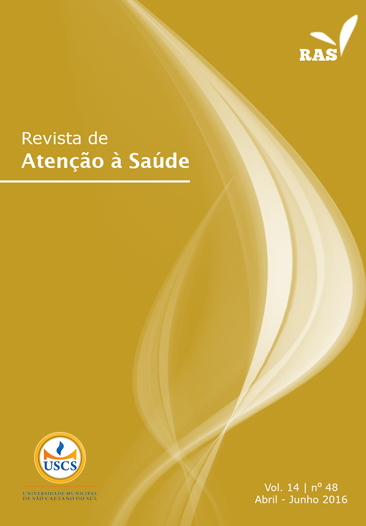Reception and health education in waiting room: evaluation of actions contributiontopediatric dentistry attendance
DOI:
https://doi.org/10.13037/ras.vol14n48.3643Keywords:
patient reception, oral health education, pediatric dentistryAbstract
Objective: Identify how activities in the waiting room contribute to the child's conditioning before dental treatment, assessing the caregiverunderstanding of oral health knowledge,children’s understandingof oral hygiene habits, empathy with the dentist and the involvement in the proposed activities and their behavior during consultation.Material and Methods: This cross and observational study was conducted in the period fromMarch 2015toJune 2015 and evaluated 30 children that awaited for dentalcare in the Integrated Children's Dental Clinic of a public college in thenorthern region ofBrazil. Children and caregivers answered a questionnaire concerningoral healthknowledge and empathy inthe dentist-patient relationship. Afterwards they participated in educational activities carried outin the waiting room bythe student responsibleand assessed their involvement in the activities. Then, the student responsible for clinicalcarewas questioned about the child's behavior during the dental appointment. RESULTS: There is a lack of basic oral healthknowledge , demonstrated by the majorcomplaints of caregiverswhenseeking dental care for children:an installed pathology (66.7%), use of shared tooth brush (6.7%) and non-use of dental floss (66.7%). Most children (96.6%) showed satisfactory involvement in activities and peaceful behavior (80.0%) during clinical care. Conclusion: playful oral health promotion activities can contribute to the acquisition of knowledge by children and caregivers,giving them greater self-careautonomy , and contributingto a less stressful and more collaborative behavior during dental treatment.
Downloads
References
Pedro ICS, Nascimento LC, PoletiLC, Lima RAG, Mello DF, Luiz FMR. O brincar em sala de espera de um ambulatório infantil na perspectiva de crianças e acompanhantes. RevLatAmEnferm.2007;15(2):284-90.
Oliveira MF, Zanchett S,BerndtRLE, Moraes MVM. Motivação no controle do biofilme dental e o aprendizado em relação à saúde bucal em escolares. PublUEPGCiBiol Saúde.2012;18(2):115-20.
Veríssimo DS, Valle ERM. A experiência vivida por pessoas com tumor cerebral e por seus familiares. PsicolArgum.2006;24(45):45-57.
Gomes SSR, Bezerra ACB, Castro AM, Tavares M, Teixeira RR, Espindola FS, et al. Comportamento em crianças pré-escolares na primeira consulta odontológica: relação entre medidas objetivas e subjetivas. J ManagPrim Health Care.2013;4(2):109-8.
Oliveira ET, Lima-Júnior JF, Soares FNCS, Maia ER. A odontologia social no contexto da promoção da saúde. RBPS.2008;21(1):75-9.
Silva JLL. Educação em saúde e promoção da saúde: a caminhada dupla para a qualidade de vida do cliente. Info Promo Saud. 2005;1(1):3.
Alves MU, Volschan BCG, Haas NAT. Education buccal health: sensibilization of children's parents assisted in pediatric dentistry child clinic of two private universities. PesqBrasOdontopedClin Integr.2004;4(1):51-5.
Lima CM, Watanabe MGC, Palha PF. Atenção precoce à saúde bucal: tarefa da equipe de saúde da família. Rev Pediatria.2006;28(3):191-8.
Nora CRD, Mânica F, Germani ARM. Sala de espera uma ferramenta para efetivar a educação em saúde. RevSaud Pesq.2009;2(3):402-6.
Reis FV, Brito JR, Santos JN, Oliveira MG. Educação em saúde na sala de espera: relato de experiência. RevMed Minas Gerais.2014;24(Supl 1):S32-6.
Nascimento LC, Pedro ICS, PoletiLC, Borges, ALV, Pfeifer LI, Lima RAG. O brincar em sala de espera de um Ambulatório Infantil: a visão dos profissionais de saúde. Rev EscEnferm USP.2011;45(2):472-8.
Stutz BL. Explorando o desenho para redução da ansiedade infantil na sala de espera em odontologia. Em Extensão.2011;10(2):162-71.
Downloads
Published
Issue
Section
License
Policy Proposal for Journals offering Free Delayed Access
Authors who publish in this magazine agree to the following terms:
- Authors maintain the copyright and grant the journal the right to the first publication, with the work simultaneously licensed under a Creative Commons Attribution License after publication, allowing the sharing of the work with recognition of the authorship of the work and initial publication in this journal.
- Authors are authorized to assume additional contracts separately, for non-exclusive distribution of the version of the work published in this magazine (eg, publishing in institutional repository or as a book chapter), with the acknowledgment of the authorship and initial publication in this journal.
- Authors are allowed and encouraged to publish and distribute their work online (eg in institutional repositories or on their personal page) at any point before or during the editorial process, as this can generate productive changes, as well as increase impact and citation of the published work (See The Effect of Open Access).









